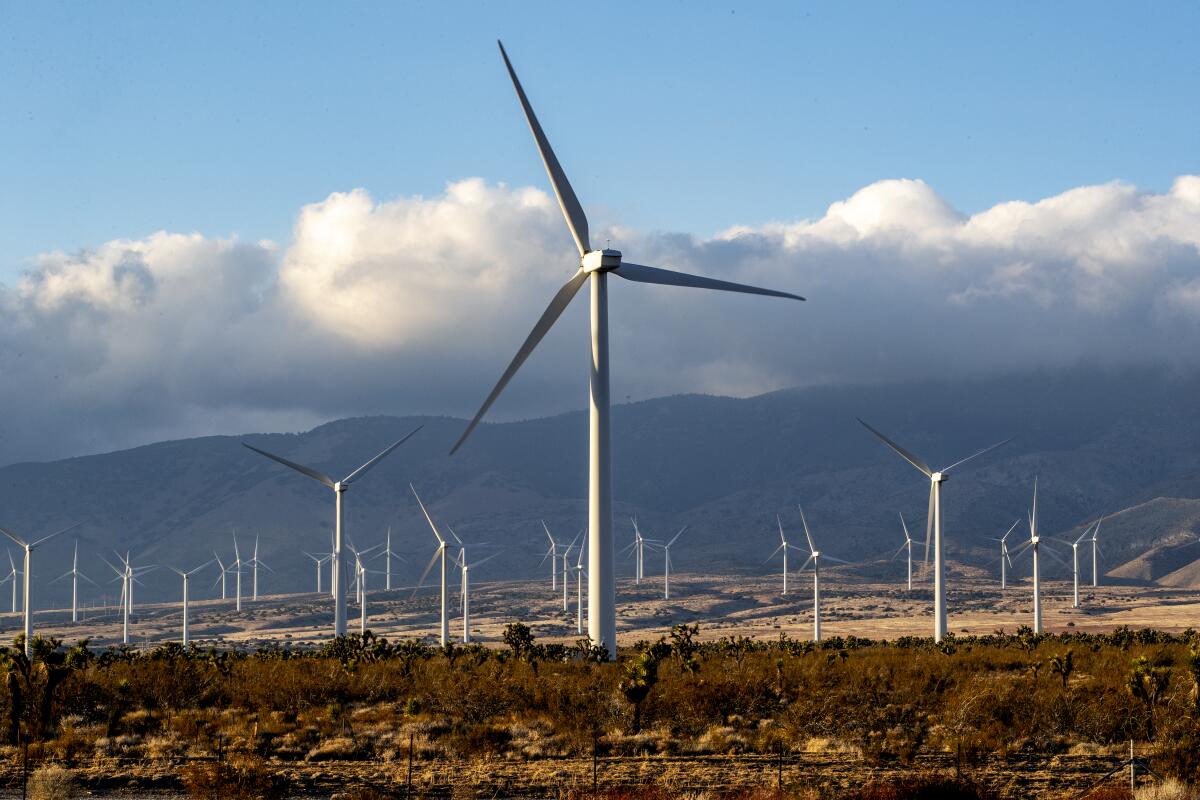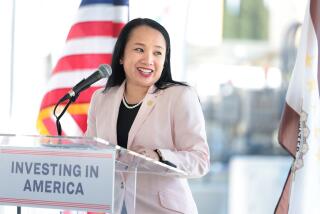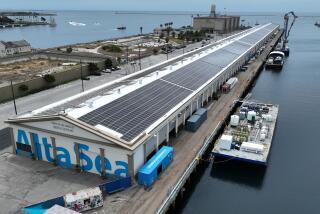Biden administration unveils offshore wind plan for California

- Share via
The federal government plans to open more than 250,000 acres off the California coast to wind development, the Biden administration announced Tuesday, as part of a major effort to ramp up the nation’s renewable energy and cut its climate-warming emissions.
Under the plan, the administration would allow wind power projects to be built in federal waters off the coast of Central California northwest of Morro Bay, as well as at a second location west of Humboldt Bay. Officials estimate that the two areas combined could generate 4,600 megawatts of electricity — enough to power 1.6 million homes.
The government’s plans represent a “breakthrough,” said Gina McCarthy, President Biden’s senior climate change advisor. “It’s an announcement that will set the stage for the long-term development of clean energy and the growth of a brand-new made-in-America industry.”
Gov. Gavin Newsom praised the plans, noting that California had spent years trying to advance offshore wind power under the Trump administration, with no success. The state, he said, will accelerate its own environmental review process in order to speed up the projects, which he estimated would be built at least 20 miles offshore with enough space for roughly 380 wind turbines.
“This is a game-changing energy production facility ... benefiting diverse communities all up and down the state of California,” Newsom said.
The announcement comes amid a surge of interest in offshore wind power, which European countries have been using successfully for more than a decade, but which the United States has been slow to adopt. Despite wind energy’s appeal — it produces no greenhouse gas emissions and has a minimal environmental footprint — it hasn’t made progress in California.
Both of the country’s two existing wind farms are in the Atlantic Ocean, and plans for the nation’s first commercial-scale wind development, which the administration recently approved, center on coastal waters off Martha’s Vineyard, Mass. A dozen more wind projects along the East Coast are under federal review.
Although there has been no shortage of interest from wind farm developers in sites along California’s coast — particularly off the Central Coast and Humboldt Bay — efforts have been stymied by regulatory obstacles, engineering challenges created by the Pacific Ocean floor’s steep drop-off, and concerns about the impact the infrastructure could have on migratory birds, marine life and fisheries.
The Department of Defense had also pushed back on expanding offshore wind power into California, warning in the past that developments could interfere with the military’s exercises and operations. But the department’s top policy officials appear to have changed their position under Biden. On Tuesday, the U.S. undersecretary of Defense for policy, Colin Kahl, said the military had worked with the White House and California officials to find locations suitable for offshore wind development that wouldn’t impede military activity.
“The Defense Department applauds this step and looks forward to continued coordination to address the climate crisis,” Kahl said in a statement.
An offshore wind project off Massachusetts that would create 800 megawatts of electricity, enough to power 400,000 homes, was approved by the federal government.
The administration’s plans for the California coast are part of a broader effort to fight climate change by shifting the country’s energy sources away from oil, gas and coal and toward cleaner technology such as solar and wind energy.
The White House has set a goal of deploying 30,000 megawatts of offshore wind by 2030. Officials estimate that hitting this target could spur $12 billion in capital investments in projects on both coasts and employ more than 77,000 people in the offshore wind industry itself and in jobs that spring up around it. They envision bringing much of the industry’s supply chain to the U.S. so that wind turbine components and the steel they’re forged from are manufactured domestically.
In its first step toward that target, administration officials in March announced plans to greatly expand wind development off the East Coast. They chose an area between the New York and New Jersey coasts, and both states committed to buy thousands of megawatts of new electricity if wind turbines are eventually installed there.
Tuesday’s announcement means that the federal government will begin holding auctions, in which wind developers will bid on the right to apply for permits to install turbines.
The Interior Department’s Bureau of Ocean Energy Management oversees this process, which can take years to unfold as proposed projects undergo environmental review and the bureau collects and responds to public comments. The first lease sale on the West Coast isn’t expected until 2022.
Even if projects clear these hurdles, they’re likely to face lawsuits and opposition campaigns from property owners along the coast, some of whom have expressed distaste at the prospect of wind turbines altering the area’s iconic ocean views.
As for the engineering challenges, the California coast presents an interesting problem: Unlike federal waters off the East Coast, which are shallow enough to allow offshore wind infrastructure to be secured to the Atlantic seafloor, the Pacific Ocean is so deep that the only viable way to install offshore wind farms would be to build floating turbines that are tethered in place by cables.
Floating offshore wind technology is still relatively new, but the industry has made significant progress in recent years. In 2017, a floating wind farm off the northeastern coast of Scotland demonstrated that it can be done.
Brandon Southall, a research associate at UC Santa Cruz who has advised East Coast projects on the responsible development of offshore wind, said that any project off the California coast would probably be different from the most-studied wind farms in Europe and on the Atlantic seafloor.
More research is needed on the acoustic impact on marine life from the banging as the infrastructure is installed, said Southall. There are also many unanswered questions about how the permanent presence of such large floating structures could affect fish activity and the potential entanglement of marine mammals.
Still, he said, Californians shouldn’t lose sight of the big-picture benefit.
“We have a reliable and predictable resource, that if developed smartly and responsibly could really help us achieve carbon neutrality,” he said.
Karen Douglas, a member of the California Energy Commission who has played a leading role in negotiations with the federal government, predicted it could be a decade before offshore wind farms start generating a significant amount of electricity. Any projects would need to undergo a thorough environmental review to study the potential consequences for fishing, shipping, marine life and views from the beach. They would also probably need the blessing of numerous state agencies.
New spending proposed by Newsom this month could help speed things up. If approved by the Legislature, about $20 million would pay for new environmental science positions at state agencies to analyze project proposals, public outreach and port upgrades at Humboldt Bay that could support the development of an offshore wind farm along the state’s North Coast, among other priorities.
The Central Coast is an especially valuable spot for offshore wind because developers could connect their projects to existing electrical grid infrastructure at the Diablo Canyon nuclear power plant near San Luis Obispo, which is scheduled to close in 2025. A shuttered gas plant in Morro Bay could also offer an ideal spot for a wind farm to connect to the grid and send electricity to Los Angeles, the Bay Area or elsewhere.
Energy experts say there’s little question that offshore wind power will eventually be needed — it’s just a matter of how much, and how soon.
A report released by several state agencies in March concluded that the cheapest path to 100% clean energy would involve building 10,000 megawatts of offshore wind — more than four times as much power as the Diablo Canyon nuclear plant generates. And that figure may be an underestimate.
Times staff writer Phil Willon contributed to this report.
More to Read
Get the L.A. Times Politics newsletter
Deeply reported insights into legislation, politics and policy from Sacramento, Washington and beyond. In your inbox twice per week.
You may occasionally receive promotional content from the Los Angeles Times.













